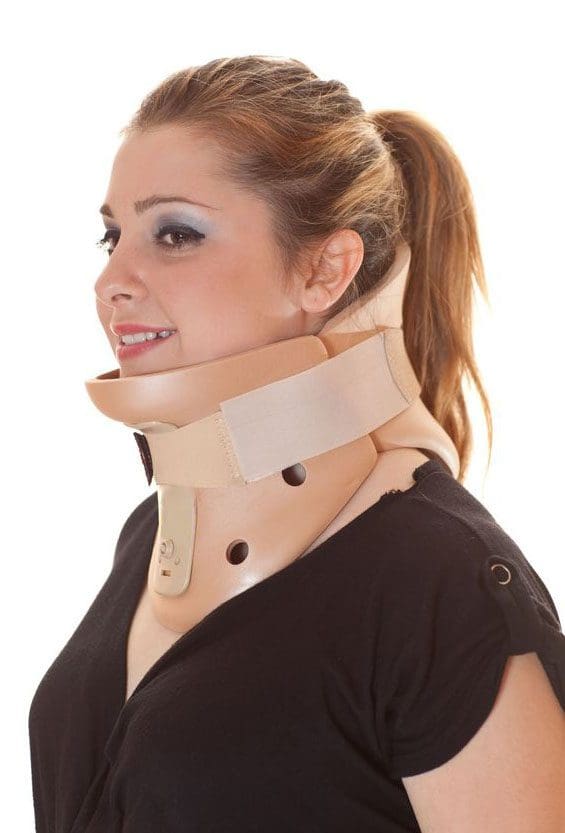An individual may need to wear a neck brace or cervical collar after cervical spine surgery, or after experiencing a traumatic injury to the neck, from an automobile accident, sports, work, or personal injury. Neck braces are some of the most common spinal braces. A doctor might call these orthoses or orthotics. There are different types of neck braces also called cervical collars, and function for different purposes.
- They can be utilized in stabilizing the neck after cervical/neck surgery.
- They can provide non-surgical relief after experiencing trauma or injury to the neck
Neck braces or collars are used to limit movement, support the head, and take the load off the neck. This gives the muscles time to rest, recover, and heal properly and thoroughly.

Table of Contents
Soft and Hard Neck Braces
Soft braces are made to be flexible and are made of a polyurethane foam rubber. They easily wrap around the neck and are secured with Velcro.
Soft collars are usually worn for a minor injury that just needs to be worn for a short time or to transition from wearing a hard brace from a more serious injury or surgery. Soft braces are worn typically at the end or completion of the healing process. The main purpose is to help with the gradual transition to remove the brace.
Hard neck braces look sort of like soft braces. The difference is that they are made of hard polyethylene and are rigid/stiff to really keep the neck from moving. These braces provide support and pain relief for spinal conditions like cervical spondylosis and acute neck pain.

Philadelphia
A Philadelphia brace is made of stiff foam and is made in two pieces that attach with Velcro. The upper portion supports the lower jaw with the lower brace extending down to cover the upper back.
This brace is made to protect more of the neck area than a soft or hard brace. However, it does place a higher restriction on the neck and body’s range of motion. Because of its effectiveness for limiting movement, it is usually prescribed after cervical surgery for a healthy recovery. The Philadelphia neck brace is also used for stabilization of minor cervical fractures and to reduce pain brought on from neck muscle strain.

Sterno-Occipital-Mandibular Immobilization
The Sternooccipital mandibular immobilization brace is a highly rigid brace used to position the neck in straight alignment with the spine. This brace immobilizes the neck completely by preventing the head and neck from moving at all. This allows the injured/damaged structures to heal correctly and quickly. Sterno comes from the sternum. The brace has a front chest plate, and bars that go over the shoulder.

It is secured with straps that attach to the front chest plate. It also has a removable chin piece where the mandibular comes from, which is the lower jawbone. And there is an optional headpiece for added protection and support. Occipital is referring to the occipital bone at the back of the head. This type of brace is used for the treatment of severe neck injury/s or cervical pain caused by a chronic condition, like arthritis. It can also aid in recovery after cervical spine surgery.
Halo
The halo brace is the most rigid of the neck braces. It completely immobilizes the head and neck from moving. Sometimes it is necessary to immobilize the spine after a major neck procedure or for stabilizing fractures in the neck or middle back area. Halo bracing is considered a form of spinal traction. Traction pulls the spine in 2 different directions.
The tension reduces the abnormal curvature associated with spinal conditions, like scoliosis. A halo brace has a metal ring secured to the head using pins. The ring is connected to bars that are attached to a properly weighted vest. The weight of a halo brace is different depending on the individual wearing it. A halo brace is worn at all times until completely healed and recovered.

Effectiveness
Neck braces are the most effective when they are used as directed by a doctor, chiropractor, or spine specialist. Working with an orthotist, or a specialist that designs and custom fits spinal braces can be extremely beneficial. Any questions about how to wear and care for a spinal brace should be brought up with a doctor or orthotist. They will help ensure a full understanding of how to get the most benefit from the treatment.
Chiropractic Neck Pain Treatment
Dr. Alex Jimenez’s Blog Post Disclaimer
The scope of our information is limited to chiropractic, musculoskeletal, physical medicines, wellness, and sensitive health issues and/or functional medicine articles, topics, and discussions. We use functional health & wellness protocols to treat and support care for injuries or disorders of the musculoskeletal system. Our posts, topics, subjects, and insights cover clinical matters, issues, and topics that relate and support directly or indirectly our clinical scope of practice.*
Our office has made a reasonable attempt to provide supportive citations and has identified the relevant research study or studies supporting our posts. We also make copies of supporting research studies available to the board and or the public upon request. We understand that we cover matters that require an additional explanation as to how it may assist in a particular care plan or treatment protocol; therefore, to further discuss the subject matter above, please feel free to ask Dr. Alex Jimenez or contact us at 915-850-0900. The provider(s) Licensed in Texas& New Mexico*
Post Disclaimer
Professional Scope of Practice *
The information on this blog site is not intended to replace a one-on-one relationship with a qualified healthcare professional or licensed physician and is not medical advice. We encourage you to make healthcare decisions based on your research and partnership with a qualified healthcare professional.
Blog Information & Scope Discussions
Welcome to El Paso's Premier Wellness and Injury Care Clinic & Wellness Blog, where Dr. Alex Jimenez, DC, FNP-C, a board-certified Family Practice Nurse Practitioner (FNP-BC) and Chiropractor (DC), presents insights on how our team is dedicated to holistic healing and personalized care. Our practice aligns with evidence-based treatment protocols inspired by integrative medicine principles, similar to those found on this site and our family practice-based chiromed.com site, focusing on restoring health naturally for patients of all ages.
Our areas of chiropractic practice include Wellness & Nutrition, Chronic Pain, Personal Injury, Auto Accident Care, Work Injuries, Back Injury, Low Back Pain, Neck Pain, Migraine Headaches, Sports Injuries, Severe Sciatica, Scoliosis, Complex Herniated Discs, Fibromyalgia, Chronic Pain, Complex Injuries, Stress Management, Functional Medicine Treatments, and in-scope care protocols.
Our information scope is limited to chiropractic, musculoskeletal, physical medicine, wellness, contributing etiological viscerosomatic disturbances within clinical presentations, associated somato-visceral reflex clinical dynamics, subluxation complexes, sensitive health issues, and functional medicine articles, topics, and discussions.
We provide and present clinical collaboration with specialists from various disciplines. Each specialist is governed by their professional scope of practice and their jurisdiction of licensure. We use functional health & wellness protocols to treat and support care for the injuries or disorders of the musculoskeletal system.
Our videos, posts, topics, subjects, and insights cover clinical matters and issues that relate to and directly or indirectly support our clinical scope of practice.*
Our office has made a reasonable effort to provide supportive citations and has identified relevant research studies that support our posts. We provide copies of supporting research studies available to regulatory boards and the public upon request.
We understand that we cover matters that require an additional explanation of how they may assist in a particular care plan or treatment protocol; therefore, to discuss the subject matter above further, please feel free to ask Dr. Alex Jimenez, DC, APRN, FNP-BC, or contact us at 915-850-0900.
We are here to help you and your family.
Blessings
Dr. Alex Jimenez DC, MSACP, APRN, FNP-BC*, CCST, IFMCP, CFMP, ATN
email: coach@elpasofunctionalmedicine.com
Licensed as a Doctor of Chiropractic (DC) in Texas & New Mexico*
Texas DC License # TX5807
New Mexico DC License # NM-DC2182
Licensed as a Registered Nurse (RN*) in Texas & Multistate
Texas RN License # 1191402
ANCC FNP-BC: Board Certified Nurse Practitioner*
Compact Status: Multi-State License: Authorized to Practice in 40 States*
Graduate with Honors: ICHS: MSN-FNP (Family Nurse Practitioner Program)
Degree Granted. Master's in Family Practice MSN Diploma (Cum Laude)
Dr. Alex Jimenez, DC, APRN, FNP-BC*, CFMP, IFMCP, ATN, CCST
My Digital Business Card


